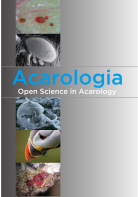Ver ítem
- xmlui.general.dspace_homeCentros e Institutos de InvestigaciónCICVyA. Centro de Investigación en Ciencias Veterinarias y AgronómicasInstituto de GenéticaArtículos científicosxmlui.ArtifactBrowser.ItemViewer.trail
- Inicio
- Centros e Institutos de Investigación
- CICVyA. Centro de Investigación en Ciencias Veterinarias y Agronómicas
- Instituto de Genética
- Artículos científicos
- Ver ítem
A method for semi-field rearing of Varroa destructor (Acari: Varroidae) to obtain mites of controlled age and specific life cycle
Resumen
Varroa destructor is one of the most devastating ectoparasites of the honey bee, Apis mellifera, worldwide. Given that V. destructor has very low survivability and exhibits no successful reproduction away from their natural environment and host and that the availability of mites for experimental purposes is limited by seasonality, several protocols of mite rearing under laboratory conditions have been developed. However, only one of these rearing systems
[ver mas...]
Varroa destructor is one of the most devastating ectoparasites of the honey bee, Apis mellifera, worldwide. Given that V. destructor has very low survivability and exhibits no successful reproduction away from their natural environment and host and that the availability of mites for experimental purposes is limited by seasonality, several protocols of mite rearing under laboratory conditions have been developed. However, only one of these rearing systems has been able to yield a fertile second generation with a low mite survival. The aim of this study was to develop a semi-field rearing method to obtain mites of known age and life cycle that can be maintained through several generations. We registered and compared survival and reproductive parameters of mites of controlled age during four generations (P, F1, F2, F3) and evidenced no significant differences between these mite groups for these life-history traits. With present results we demonstrate that it is possible to successfully produce a third generation of mites under semi-field conditions. This study brings useful information about key conditions for the proper reproduction of mites in a controlled rearing system and provides a potential standardized method for V. destructor research, especially for host-parasite interaction experiments.
[Cerrar]

Fuente
Acarologia 63 (2) : 383-389 (Marzo 2023)
Fecha
2023-03
Editorial
Les Amis d'Acarologia
ISSN
2107-7207
Documentos Relacionados
Formato
pdf
Tipo de documento
artículo
Proyectos
(ver más)
INTA/2019-PE-E1-I017-001, DESARROLLO DEL SECTOR APÍCOLA ORGANIZADO, SUSTENTABLE Y COMPETITIVO
Palabras Claves
Derechos de acceso
Abierto
 Excepto donde se diga explicitamente, este item se publica bajo la siguiente descripción: Creative Commons Attribution-NonCommercial-ShareAlike 2.5 Unported (CC BY-NC-SA 2.5)
Excepto donde se diga explicitamente, este item se publica bajo la siguiente descripción: Creative Commons Attribution-NonCommercial-ShareAlike 2.5 Unported (CC BY-NC-SA 2.5)


